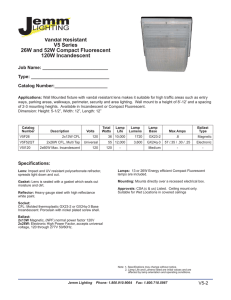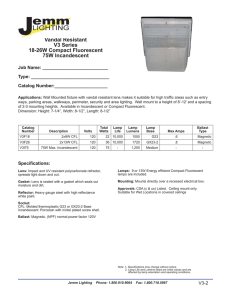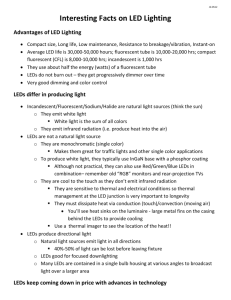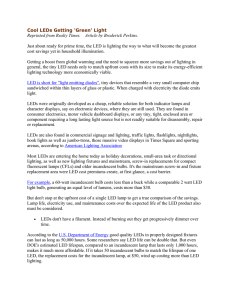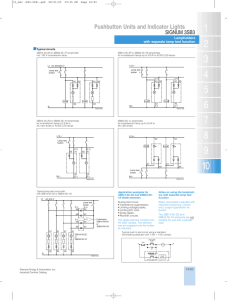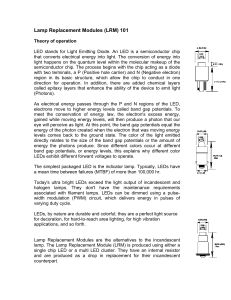led education - E
advertisement
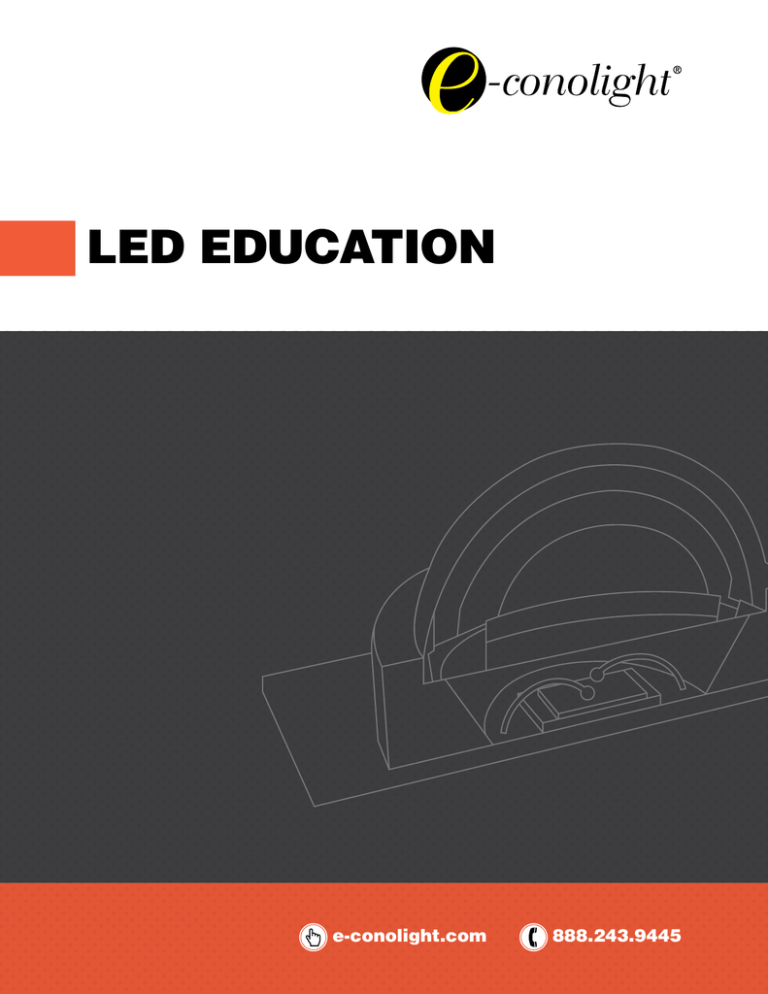
LED EDUCATION e-conolight.com 888.243.9445 Before learning about LEDs, it’s important to first have knowledge of traditional light sources and lighting terms. Incandescent These lamps produce light using electricity to heat a metal filament until it becomes “white” hot. As a result, incandescent bulbs convert only about 5% of the energy to visible light; the rest goes to creating heat. That’s why you’ll burn your hand if you try to touch one when it’s on. Compact Fluorescent (CFL) These lamps have an electric current that flows between electrodes at each end of a tube containing mercury-vapor gases. This reaction of mercury in the arc stream produces ultraviolet (UV) light and heat. The UV light is transformed into visible light when it strikes a phosphor coating on the inside of the bulb. High intensity discharge (HID) All High Pressure Sodium (HPS), Metal Halide (MH), and Pulse Start Metal Halide (PSMH) lamps utilize HID technology. They produce light by means of an electric arc between electrodes housed inside an arc tube. This tube is filled with both gas and metal salts, including mercury. Once the arc is started, it heats and evaporates the metal salts forming a plasma, which greatly increases the intensity of light produced by the arc tube. light emitting diodes (LEDs) These consist of a semiconductor diode that emits light when a current is applied to it. They have no moving, fragile parts and can last for decades. LED lighting can use up to 85 percent less electricity than incandescent bulbs and up to 50 percent less electricity than fluorescent. The long life, low maintenance costs, no poisonous mercury and energy efficiency associated with LEDs have helped accelerate their adoption in many general lighting applications. Incandescent 2700K 2000K Halogen 3000K 3000K Metal Halide Fluorescent 4000K 4100K 4000K Sunlight 5000K 5000K White LED Typical CCTs of different light sources. 2 6000K 7000K Correlated Color temperature (CCT) This is defined as the color of light that most closely matches the light emitted from a black body radiator when heated to a certain Kelvin temperature (Celsius plus 273). Incandescent lamps have a typical CCT of 2700K (warm white light). Fluorescent lamps can have CCTs that vary from 3000K to 5000K (cool white light). Typical white LEDs have CCTs that vary from 2700K to 6500K, which means you don't have to use different inefficient light sources. The CCT for a light source gives a good indication of the lamp’s color but does not give information on its effects on object colors (CRI). This means two lamps may have the same color temperature but affect object colors differently. What an LED package looks like. Lens/Optic Bond Wire LED Chip Junction Submount Reflector Substrate the color rendering index This is defined as a light source’s ability to render color. The higher the CRI (100 being the highest), the better the light source renders color relative to a reference source. For interior applications, the reference source is incandescent; for exterior applications, the reference source is the sun. What does AN LED system look like? A basic LED system consists of the LED and LED optic, a thermal system for managing heat generated from the LED, and an electronic LED driver. The thermal system usually consists of the LED mounted on a substrate such as a printed circuit board (PCB), and a heat sink to dissipate the heat from the LED. Do I have to replace LEDs? An LED does not burn out like a standard lamp, so the individual LEDs do not need to be replaced. If one LED fails, it does not necessarily produce a complete fixture outage such as in an incandescent or HID fixture. How does an LED generate white light? Because white LEDs do not exist, different colors have to be mixed to produce white light. One of the ways this is done is by taking a blue LED chip and then coating it with a yellow phosphor. The amount of phosphor determines how much of the blue light is converted to white light. The amount or type of phosphor can be varied to generate warmer (yellow) or cooler (blue white) light. Typically more phosphors are required to create warmer light, which generally results in less lumen output. Yellow Phosphor Blue LED Chip Blue light and yellow light combine to make white light. What are the advantages of LED? LEDs have several advantages including durability, less energy to operate, and long life compared to other light sources. This translates into energy savings, maintenance savings, and environmental sustainability. LEDs can also be dimmed and turn on and off instantly. Since they don’t emit ultraviolet (UV) or infrared (IR) radiation, LED is ideal for produce, meat, retail and other fine art applications since it won’t fade objects. 3 How efficient is LED? Compared to traditional lighting technologies, E-conolight LED light fixtures can deliver the same amount of light using up to 75% less energy. This huge reduction in energy consumption means saving hundreds of dollars over the life of each light. An E-conolight fixture like the 5" and 6" LED Recessed Retrofit Kit (E-T6A Series) replaces a 65-watt incandescent lamp while using only 16 watts. In its 50,000 hour lifetime it will cost about $96 in energy1. During that time it will never need to be replaced. As a comparison, a typical 65-watt lamp will cost about $390 in energy over 50,000 hours2. That means for every 65-watt downlight you replace, you’re saving almost $300 per light. And this doesn’t include the money saved by not having to replace those incandescent lamps. Since a typical 65-watt lamp lasts for 2,000 hours, you’ll be replacing that one lamp about 25 times over 50,000 hours. The long life of E-conolight fixtures means that you might never change another light again. 40 34.2 YEARS 30 22.8 20 17.1 How long is 50,000 hours? It is about 50 times the life of a typical incandescent lamp and about 5 times the lifetime of an average compact fluorescent lamp. If you ran the LED Recessed Retrofit Kit 6 hours per day every day, it would last for over 20 years! 11.4 10 5.7 24 12 8 6 HOURS PER DAY 4 1 16 watts x $0.12/kWh energy cost x 50,000 hours / 1000 = $96 2 65 watts x $0.12/kWh energy cost x 50,000 hours / 1000 = $390 What 50,000 hours looks like in terms of years. great products. low pricing. fast shipping. LED LAY-IN TROFFER LED WALL PACK LED RECESSED RETROFIT E-TR Series E-WP1L & E-WP4L Series E-T6A Series

